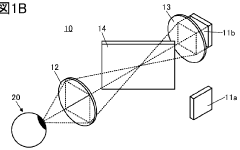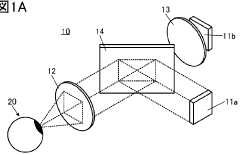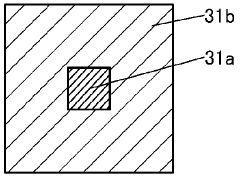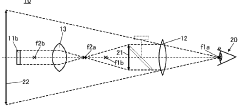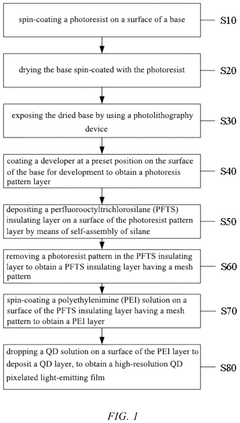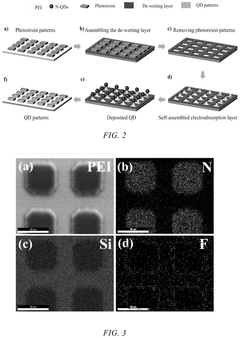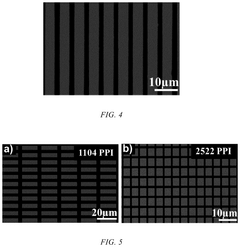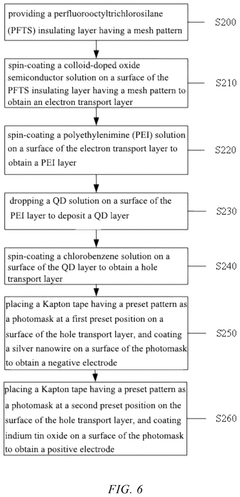How to Integrate Realism in Digital Displays with QLED?
JUN 20, 20259 MIN READ
Generate Your Research Report Instantly with AI Agent
Patsnap Eureka helps you evaluate technical feasibility & market potential.
QLED Display Evolution
QLED (Quantum Dot Light Emitting Diode) display technology has undergone significant evolution since its inception, marking a transformative journey in the realm of digital displays. The development of QLED technology can be traced back to the early 2000s when researchers began exploring the potential of quantum dots in display applications.
Initially, quantum dots were primarily used as a color enhancement layer in LCD displays. This early implementation focused on improving color accuracy and expanding the color gamut of existing LCD technology. The first commercial QLED TVs, introduced in the mid-2010s, utilized this approach, offering superior color performance compared to traditional LED-backlit LCD displays.
As the technology matured, manufacturers began to refine the quantum dot implementation, leading to improved efficiency and color purity. The introduction of cadmium-free quantum dots in the late 2010s addressed environmental concerns and paved the way for wider adoption of QLED technology in consumer electronics.
A significant milestone in QLED evolution was the development of photo-emissive quantum dot displays. This advancement allowed quantum dots to emit light directly when excited by an electric current, rather than merely acting as a color filter for an LED backlight. This shift brought QLED technology closer to the performance characteristics of OLED displays, particularly in terms of contrast and black levels.
Recent years have seen further innovations in QLED technology, including the integration of mini-LED backlighting systems. This combination, often referred to as Neo QLED or similar branded terms, has dramatically improved local dimming capabilities, resulting in enhanced contrast ratios and more precise control over brightness levels across the display.
The pursuit of realism in QLED displays has been a driving force behind many of these advancements. Manufacturers have focused on expanding the color volume, increasing peak brightness, and improving HDR performance to create more lifelike and immersive visual experiences. The latest QLED displays boast color volumes approaching 100% of the DCI-P3 color space and peak brightness levels exceeding 2,000 nits, setting new standards for HDR content reproduction.
Looking ahead, the evolution of QLED technology is expected to continue with a focus on achieving even greater color accuracy, higher refresh rates for smoother motion, and improved energy efficiency. Research into self-emissive quantum dot displays, which could potentially rival or surpass OLED technology in terms of picture quality and manufacturing cost, represents the next frontier in QLED evolution.
Initially, quantum dots were primarily used as a color enhancement layer in LCD displays. This early implementation focused on improving color accuracy and expanding the color gamut of existing LCD technology. The first commercial QLED TVs, introduced in the mid-2010s, utilized this approach, offering superior color performance compared to traditional LED-backlit LCD displays.
As the technology matured, manufacturers began to refine the quantum dot implementation, leading to improved efficiency and color purity. The introduction of cadmium-free quantum dots in the late 2010s addressed environmental concerns and paved the way for wider adoption of QLED technology in consumer electronics.
A significant milestone in QLED evolution was the development of photo-emissive quantum dot displays. This advancement allowed quantum dots to emit light directly when excited by an electric current, rather than merely acting as a color filter for an LED backlight. This shift brought QLED technology closer to the performance characteristics of OLED displays, particularly in terms of contrast and black levels.
Recent years have seen further innovations in QLED technology, including the integration of mini-LED backlighting systems. This combination, often referred to as Neo QLED or similar branded terms, has dramatically improved local dimming capabilities, resulting in enhanced contrast ratios and more precise control over brightness levels across the display.
The pursuit of realism in QLED displays has been a driving force behind many of these advancements. Manufacturers have focused on expanding the color volume, increasing peak brightness, and improving HDR performance to create more lifelike and immersive visual experiences. The latest QLED displays boast color volumes approaching 100% of the DCI-P3 color space and peak brightness levels exceeding 2,000 nits, setting new standards for HDR content reproduction.
Looking ahead, the evolution of QLED technology is expected to continue with a focus on achieving even greater color accuracy, higher refresh rates for smoother motion, and improved energy efficiency. Research into self-emissive quantum dot displays, which could potentially rival or surpass OLED technology in terms of picture quality and manufacturing cost, represents the next frontier in QLED evolution.
Market Demand Analysis
The market demand for integrating realism in digital displays with QLED technology has been steadily growing, driven by consumers' increasing expectations for immersive visual experiences. As the entertainment industry, gaming sector, and professional markets continue to evolve, there is a rising need for displays that can deliver lifelike images with superior color accuracy, contrast, and brightness.
In the consumer electronics market, QLED technology has gained significant traction, particularly in high-end televisions. The global QLED TV market size was valued at $8.5 billion in 2020 and is projected to reach $27.9 billion by 2026, growing at a CAGR of 21.9% during the forecast period. This growth is largely attributed to the technology's ability to provide enhanced picture quality and realism compared to traditional LED displays.
The gaming industry has emerged as a key driver for realistic display technologies. With the advent of next-generation consoles and high-performance gaming PCs, gamers are demanding displays that can accurately render complex graphics and provide a more immersive gaming experience. The gaming monitor market, which heavily relies on advanced display technologies, is expected to grow from $3.9 billion in 2020 to $6.4 billion by 2025, with a CAGR of 10.4%.
Professional markets, including graphic design, video editing, and scientific visualization, are also contributing to the demand for realistic displays. These sectors require displays with high color accuracy, wide color gamut, and precise image reproduction. The professional display market is forecasted to reach $5.7 billion by 2025, growing at a CAGR of 6.2% from 2020 to 2025.
The automotive industry represents another significant market for realistic display technologies. As vehicles become more technologically advanced, there is an increasing demand for high-quality in-vehicle displays for infotainment systems, digital dashboards, and heads-up displays. The automotive display market is expected to grow from $9.8 billion in 2020 to $14.6 billion by 2025, with a CAGR of 8.3%.
Despite the growing demand, there are challenges that need to be addressed. Cost remains a significant factor, as QLED displays are generally more expensive than traditional LED displays. Additionally, there is competition from other emerging display technologies, such as OLED and MicroLED, which also promise enhanced realism and image quality.
In conclusion, the market demand for integrating realism in digital displays with QLED technology is robust and diverse, spanning multiple industries. As technological advancements continue and production costs decrease, the adoption of QLED and other realistic display technologies is expected to accelerate, further driving market growth and innovation in the coming years.
In the consumer electronics market, QLED technology has gained significant traction, particularly in high-end televisions. The global QLED TV market size was valued at $8.5 billion in 2020 and is projected to reach $27.9 billion by 2026, growing at a CAGR of 21.9% during the forecast period. This growth is largely attributed to the technology's ability to provide enhanced picture quality and realism compared to traditional LED displays.
The gaming industry has emerged as a key driver for realistic display technologies. With the advent of next-generation consoles and high-performance gaming PCs, gamers are demanding displays that can accurately render complex graphics and provide a more immersive gaming experience. The gaming monitor market, which heavily relies on advanced display technologies, is expected to grow from $3.9 billion in 2020 to $6.4 billion by 2025, with a CAGR of 10.4%.
Professional markets, including graphic design, video editing, and scientific visualization, are also contributing to the demand for realistic displays. These sectors require displays with high color accuracy, wide color gamut, and precise image reproduction. The professional display market is forecasted to reach $5.7 billion by 2025, growing at a CAGR of 6.2% from 2020 to 2025.
The automotive industry represents another significant market for realistic display technologies. As vehicles become more technologically advanced, there is an increasing demand for high-quality in-vehicle displays for infotainment systems, digital dashboards, and heads-up displays. The automotive display market is expected to grow from $9.8 billion in 2020 to $14.6 billion by 2025, with a CAGR of 8.3%.
Despite the growing demand, there are challenges that need to be addressed. Cost remains a significant factor, as QLED displays are generally more expensive than traditional LED displays. Additionally, there is competition from other emerging display technologies, such as OLED and MicroLED, which also promise enhanced realism and image quality.
In conclusion, the market demand for integrating realism in digital displays with QLED technology is robust and diverse, spanning multiple industries. As technological advancements continue and production costs decrease, the adoption of QLED and other realistic display technologies is expected to accelerate, further driving market growth and innovation in the coming years.
QLED Tech Challenges
QLED technology, while promising, faces several significant challenges in its quest to integrate realism into digital displays. One of the primary hurdles is achieving consistent color accuracy across the entire display. QLED displays often struggle with maintaining uniform color reproduction, especially at different viewing angles. This can result in color shifts and reduced image quality when viewed from off-center positions, impacting the overall realism of the displayed content.
Another major challenge lies in enhancing the contrast ratio and black levels of QLED displays. While QLEDs offer improved brightness compared to traditional LED-LCD displays, they still lag behind OLED technology in terms of producing deep blacks and high contrast ratios. This limitation can affect the display's ability to render realistic shadows and dark scenes, potentially compromising the overall visual experience.
The issue of motion handling also presents a significant hurdle for QLED technology. Fast-moving images can sometimes appear blurry or exhibit artifacts, detracting from the realism of the displayed content. This is particularly noticeable in action scenes or sports broadcasts, where smooth motion is crucial for maintaining a sense of realism.
QLED displays also face challenges in terms of power efficiency. While they are generally more energy-efficient than traditional LED-LCD displays, they still consume more power than OLED alternatives, especially when displaying bright content. This can lead to increased heat generation and potential longevity issues, which may impact the display's ability to maintain consistent performance over time.
The manufacturing process for QLED displays presents its own set of challenges. Achieving uniform quantum dot distribution across large display areas can be difficult, leading to potential inconsistencies in color reproduction and overall image quality. Additionally, the complexity of the manufacturing process can result in higher production costs, potentially limiting the widespread adoption of QLED technology in consumer electronics.
Lastly, QLED technology faces challenges in terms of response time and input lag. While improvements have been made, QLED displays still struggle to match the near-instantaneous response times of OLED displays. This can result in subtle motion blur and reduced responsiveness, which can be particularly noticeable in gaming applications or fast-paced content.
Addressing these challenges will be crucial for the continued development and adoption of QLED technology in the pursuit of more realistic digital displays. Overcoming these hurdles will require ongoing research and innovation in areas such as quantum dot engineering, backlight technology, and display driver algorithms.
Another major challenge lies in enhancing the contrast ratio and black levels of QLED displays. While QLEDs offer improved brightness compared to traditional LED-LCD displays, they still lag behind OLED technology in terms of producing deep blacks and high contrast ratios. This limitation can affect the display's ability to render realistic shadows and dark scenes, potentially compromising the overall visual experience.
The issue of motion handling also presents a significant hurdle for QLED technology. Fast-moving images can sometimes appear blurry or exhibit artifacts, detracting from the realism of the displayed content. This is particularly noticeable in action scenes or sports broadcasts, where smooth motion is crucial for maintaining a sense of realism.
QLED displays also face challenges in terms of power efficiency. While they are generally more energy-efficient than traditional LED-LCD displays, they still consume more power than OLED alternatives, especially when displaying bright content. This can lead to increased heat generation and potential longevity issues, which may impact the display's ability to maintain consistent performance over time.
The manufacturing process for QLED displays presents its own set of challenges. Achieving uniform quantum dot distribution across large display areas can be difficult, leading to potential inconsistencies in color reproduction and overall image quality. Additionally, the complexity of the manufacturing process can result in higher production costs, potentially limiting the widespread adoption of QLED technology in consumer electronics.
Lastly, QLED technology faces challenges in terms of response time and input lag. While improvements have been made, QLED displays still struggle to match the near-instantaneous response times of OLED displays. This can result in subtle motion blur and reduced responsiveness, which can be particularly noticeable in gaming applications or fast-paced content.
Addressing these challenges will be crucial for the continued development and adoption of QLED technology in the pursuit of more realistic digital displays. Overcoming these hurdles will require ongoing research and innovation in areas such as quantum dot engineering, backlight technology, and display driver algorithms.
Current QLED Solutions
01 Quantum dot composition and structure
QLED technology utilizes quantum dots with specific compositions and structures to enhance color realism. These quantum dots are typically made of semiconductor materials and can be engineered to emit precise wavelengths of light, resulting in more vibrant and accurate colors. The size, shape, and composition of quantum dots are crucial factors in determining their optical properties and overall display performance.- Quantum dot composition and structure: QLED technology utilizes quantum dots with specific compositions and structures to enhance color realism. These quantum dots are typically made of semiconductor materials and can be engineered to emit precise wavelengths of light. The size, shape, and composition of quantum dots are crucial factors in determining the color output and overall performance of QLED displays.
- Light-emitting layer design: The design of the light-emitting layer in QLED devices plays a significant role in achieving realistic color reproduction. This layer often incorporates quantum dots in a matrix or specific arrangement to optimize light emission and color purity. Advanced techniques for depositing and patterning quantum dots in the light-emitting layer contribute to improved display performance and realism.
- Color conversion and enhancement: QLED technology employs various color conversion and enhancement techniques to achieve more realistic and vibrant displays. These may include the use of color filters, specialized optical films, or advanced algorithms to process and optimize the light output from quantum dots. Such techniques help in expanding the color gamut and improving color accuracy in QLED displays.
- Quantum dot excitation methods: Different methods of exciting quantum dots in QLED displays can impact the realism of the image. These may include electrical excitation, photo-excitation, or hybrid approaches. The choice and optimization of excitation methods can affect factors such as energy efficiency, color purity, and overall display performance, contributing to more realistic visual experiences.
- Integration with display technologies: The integration of QLED technology with other display technologies and components is crucial for achieving realistic visual output. This includes combining quantum dots with LED backlighting systems, incorporating them into various display architectures, and optimizing their interaction with other display elements such as polarizers and substrates. Effective integration enhances overall display performance and realism.
02 Light-emitting layer design
The design of the light-emitting layer in QLED displays plays a significant role in achieving realistic image quality. This layer often incorporates quantum dots in a carefully engineered structure to optimize light emission and color purity. Advanced techniques such as patterning and multi-layer designs are employed to enhance the efficiency and color performance of QLED displays.Expand Specific Solutions03 Color conversion and enhancement
QLED technology employs various color conversion and enhancement techniques to improve realism. This includes the use of color filters, phosphors, and specialized quantum dot materials to achieve a wider color gamut and more accurate color reproduction. Advanced algorithms and processing techniques are also utilized to optimize color performance and maintain consistency across different viewing conditions.Expand Specific Solutions04 Quantum dot integration methods
The integration of quantum dots into display devices is crucial for achieving realistic image quality. Various methods are employed, including solution-based processes, inkjet printing, and photolithography techniques. These integration methods aim to ensure uniform distribution of quantum dots, minimize defects, and optimize the overall performance of QLED displays.Expand Specific Solutions05 Backlight and optical design
The design of the backlight system and optical components in QLED displays significantly impacts image realism. Advanced optical designs, including light guide plates, reflectors, and diffusers, are used to enhance light uniformity and efficiency. Additionally, local dimming techniques and specialized optical films are employed to improve contrast and color accuracy, contributing to a more realistic viewing experience.Expand Specific Solutions
Key QLED Manufacturers
The integration of realism in digital displays using QLED technology is currently in a growth phase, with the market size expanding rapidly due to increasing demand for high-quality visual experiences. The technology's maturity is advancing, with key players like Samsung Electronics Co., Ltd. and TCL China Star Optoelectronics Technology Co., Ltd. leading the way in QLED development. Other significant contributors include BOE Technology Group Co., Ltd. and Sharp Corp., who are actively improving display technologies. The competitive landscape is intense, with companies like Apple, Inc. and Sony Interactive Entertainment LLC also investing in advanced display solutions, potentially incorporating QLED or competing technologies to enhance realism in their products.
BOE Technology Group Co., Ltd.
Technical Solution: BOE has developed its own QLED technology, focusing on improving color gamut and brightness while maintaining cost-effectiveness. Their approach involves using a specially designed quantum dot film that enhances color purity and light efficiency. BOE has also implemented advanced local dimming algorithms to improve contrast ratios in their QLED displays. Additionally, they have developed a unique manufacturing process that allows for more uniform quantum dot distribution, resulting in more consistent color performance across the entire display.
Strengths: Cost-effective production methods, making QLED technology more accessible. Weaknesses: Slightly lower peak brightness compared to some competitors' QLED offerings.
Samsung Electronics Co., Ltd.
Technical Solution: Samsung has developed advanced QLED technology that uses quantum dots to enhance color accuracy and brightness in digital displays. Their latest QLED TVs incorporate a layer of quantum dots between the LED backlight and LCD panel, which converts blue light into pure red and green light. This results in a wider color gamut and improved color volume. Samsung has also implemented local dimming technology to enhance contrast ratios and reduce blooming effects, further improving picture quality and realism.
Strengths: Superior color accuracy, high brightness levels, and wide viewing angles. Weaknesses: Higher production costs compared to traditional LED displays, and potential for image retention in static content scenarios.
QLED Core Innovations
Electronic apparatus
PatentWO2023119041A1
Innovation
- The use of a dual-display device configuration with a half mirror and lenses to superimpose and magnify images, allowing for high pixel density and large viewing angles without increasing power consumption, and employing organic light-emitting elements with separate EL layers for high-definition and low-power display.
Method for preparing high-resolution quantum dot (QD) pixelated light-emitting film
PatentActiveUS12120941B1
Innovation
- A method involving spin-coating a photoresist, exposing, and developing to create a pattern, followed by depositing a perfluorooctyltrichlorosilane (PFTS) insulating layer, then a polyethylenimine (PEI) layer, and finally a QD layer, using self-assembly and electrostatic interactions to avoid direct photolithography on the QD layer, thereby preventing damage and improving film quality.
Color Gamut Standards
Color gamut standards play a crucial role in defining and measuring the range of colors that can be accurately reproduced by digital displays, including QLED technology. These standards are essential for ensuring consistency and quality across different devices and platforms.
The most widely recognized color gamut standards in the display industry include sRGB, Adobe RGB, DCI-P3, and Rec. 2020. sRGB, developed by Microsoft and HP, is the most common standard for consumer electronics and web content. It covers approximately 35% of the visible color spectrum and is well-suited for everyday use.
Adobe RGB, introduced by Adobe Systems, offers a wider color range than sRGB, particularly in the cyan-green areas. This standard is popular in the printing and photography industries, covering about 50% of the visible spectrum. DCI-P3, originally developed for digital cinema, has gained traction in consumer displays due to its broader color range, encompassing roughly 45% of the visible spectrum.
Rec. 2020, also known as BT.2020, is the most ambitious color gamut standard, covering approximately 75% of the visible spectrum. It was designed for ultra-high-definition television (UHDTV) and is considered the gold standard for future display technologies.
QLED technology, with its quantum dot-enhanced LED backlighting, has the potential to achieve a wider color gamut than traditional LED displays. Many QLED displays can cover 100% of the DCI-P3 color space and even approach the Rec. 2020 standard. This capability allows QLED displays to render more vibrant and lifelike colors, contributing to enhanced realism in digital content.
To integrate realism in digital displays using QLED technology, manufacturers must carefully calibrate their displays to accurately reproduce colors within these standardized gamuts. This process involves precise color mapping and adjustment of the quantum dot layer to ensure that the display can faithfully represent the intended colors of digital content.
Furthermore, content creators and display manufacturers must work together to ensure that content is produced and distributed in formats that take advantage of these wider color gamuts. This collaboration is essential for delivering a truly immersive and realistic viewing experience to end-users.
As QLED technology continues to evolve, we can expect further improvements in color accuracy and gamut coverage. This progress will likely lead to the development of new color standards that push the boundaries of what is currently achievable, bringing us closer to displays that can reproduce the full range of colors visible to the human eye.
The most widely recognized color gamut standards in the display industry include sRGB, Adobe RGB, DCI-P3, and Rec. 2020. sRGB, developed by Microsoft and HP, is the most common standard for consumer electronics and web content. It covers approximately 35% of the visible color spectrum and is well-suited for everyday use.
Adobe RGB, introduced by Adobe Systems, offers a wider color range than sRGB, particularly in the cyan-green areas. This standard is popular in the printing and photography industries, covering about 50% of the visible spectrum. DCI-P3, originally developed for digital cinema, has gained traction in consumer displays due to its broader color range, encompassing roughly 45% of the visible spectrum.
Rec. 2020, also known as BT.2020, is the most ambitious color gamut standard, covering approximately 75% of the visible spectrum. It was designed for ultra-high-definition television (UHDTV) and is considered the gold standard for future display technologies.
QLED technology, with its quantum dot-enhanced LED backlighting, has the potential to achieve a wider color gamut than traditional LED displays. Many QLED displays can cover 100% of the DCI-P3 color space and even approach the Rec. 2020 standard. This capability allows QLED displays to render more vibrant and lifelike colors, contributing to enhanced realism in digital content.
To integrate realism in digital displays using QLED technology, manufacturers must carefully calibrate their displays to accurately reproduce colors within these standardized gamuts. This process involves precise color mapping and adjustment of the quantum dot layer to ensure that the display can faithfully represent the intended colors of digital content.
Furthermore, content creators and display manufacturers must work together to ensure that content is produced and distributed in formats that take advantage of these wider color gamuts. This collaboration is essential for delivering a truly immersive and realistic viewing experience to end-users.
As QLED technology continues to evolve, we can expect further improvements in color accuracy and gamut coverage. This progress will likely lead to the development of new color standards that push the boundaries of what is currently achievable, bringing us closer to displays that can reproduce the full range of colors visible to the human eye.
Energy Efficiency
Energy efficiency is a critical aspect of QLED (Quantum Dot Light-Emitting Diode) technology in the pursuit of integrating realism in digital displays. QLED displays have made significant strides in improving energy efficiency while maintaining high-quality visual performance.
One of the key factors contributing to the energy efficiency of QLED displays is the use of quantum dots. These nanocrystals are highly efficient at converting light, allowing for better color reproduction with less energy consumption. The quantum dots can be precisely tuned to emit specific colors, reducing the need for color filters that typically absorb a significant portion of light in traditional LCD displays.
QLED technology also benefits from advancements in backlight systems. The use of mini-LED backlights, for instance, allows for more precise local dimming, which not only enhances contrast but also reduces power consumption by selectively illuminating only the necessary areas of the screen. This targeted approach to backlighting significantly improves energy efficiency compared to traditional edge-lit or full-array LED backlighting systems.
Furthermore, the implementation of advanced power management systems in QLED displays has contributed to their energy efficiency. These systems can dynamically adjust the display's brightness and color output based on ambient lighting conditions and content being displayed, optimizing power usage without compromising visual quality.
Recent developments in QLED technology have focused on improving the quantum yield of quantum dots, which directly impacts energy efficiency. Higher quantum yield means more efficient light conversion, resulting in brighter displays that require less power to achieve the same level of luminance as their predecessors.
The integration of AI-driven algorithms in QLED displays has also played a role in enhancing energy efficiency. These algorithms can analyze incoming video signals in real-time, optimizing color reproduction and brightness levels on a frame-by-frame basis. This intelligent processing ensures that the display uses only the necessary amount of energy to produce vivid and realistic images.
As QLED technology continues to evolve, researchers are exploring new materials and manufacturing processes to further improve energy efficiency. This includes the development of more stable quantum dot materials that maintain their efficiency over longer periods, as well as innovative encapsulation techniques to protect the quantum dots from degradation.
In conclusion, the integration of realism in digital displays with QLED technology has been accompanied by significant advancements in energy efficiency. Through the use of quantum dots, advanced backlighting systems, intelligent power management, and ongoing research into materials and processes, QLED displays are setting new standards for energy-efficient, high-quality visual experiences.
One of the key factors contributing to the energy efficiency of QLED displays is the use of quantum dots. These nanocrystals are highly efficient at converting light, allowing for better color reproduction with less energy consumption. The quantum dots can be precisely tuned to emit specific colors, reducing the need for color filters that typically absorb a significant portion of light in traditional LCD displays.
QLED technology also benefits from advancements in backlight systems. The use of mini-LED backlights, for instance, allows for more precise local dimming, which not only enhances contrast but also reduces power consumption by selectively illuminating only the necessary areas of the screen. This targeted approach to backlighting significantly improves energy efficiency compared to traditional edge-lit or full-array LED backlighting systems.
Furthermore, the implementation of advanced power management systems in QLED displays has contributed to their energy efficiency. These systems can dynamically adjust the display's brightness and color output based on ambient lighting conditions and content being displayed, optimizing power usage without compromising visual quality.
Recent developments in QLED technology have focused on improving the quantum yield of quantum dots, which directly impacts energy efficiency. Higher quantum yield means more efficient light conversion, resulting in brighter displays that require less power to achieve the same level of luminance as their predecessors.
The integration of AI-driven algorithms in QLED displays has also played a role in enhancing energy efficiency. These algorithms can analyze incoming video signals in real-time, optimizing color reproduction and brightness levels on a frame-by-frame basis. This intelligent processing ensures that the display uses only the necessary amount of energy to produce vivid and realistic images.
As QLED technology continues to evolve, researchers are exploring new materials and manufacturing processes to further improve energy efficiency. This includes the development of more stable quantum dot materials that maintain their efficiency over longer periods, as well as innovative encapsulation techniques to protect the quantum dots from degradation.
In conclusion, the integration of realism in digital displays with QLED technology has been accompanied by significant advancements in energy efficiency. Through the use of quantum dots, advanced backlighting systems, intelligent power management, and ongoing research into materials and processes, QLED displays are setting new standards for energy-efficient, high-quality visual experiences.
Unlock deeper insights with Patsnap Eureka Quick Research — get a full tech report to explore trends and direct your research. Try now!
Generate Your Research Report Instantly with AI Agent
Supercharge your innovation with Patsnap Eureka AI Agent Platform!
